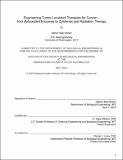| dc.description.abstract | Surgery, radiation therapy, and chemotherapy are mainstays of cancer treatment, treating cancer by directly removing or killing cancer cells. In recent decades, alternative treatments such as targeted therapy and immunotherapy have revolutionized the treatment of cancer, improving tumor control and increasing survival in a growing subset of cancer patients. Immunotherapies activate the patient’s immune system to recognize and kill cancer cells, while targeted therapies broadly target molecules or pathways involved in growth and survival of cancer cells. Despite the success of these therapies, there are still many patients that do not respond and could benefit from further development of targeted therapies, immunotherapies, and combinations with existing therapies.
Broadly, this thesis focuses on the development and preclinical testing of tumor-localized, protein therapeutics for cancer. First, we explore the potential of the antioxidant enzyme catalase to control tumor growth via scavenging of hydrogen peroxide and production of oxygen in the tumor. After engineering approaches to maximize intratumoral catalase exposure, we performed in vitro characterization and in vivo validation of our approaches in syngeneic mouse tumor models but failed to show therapeutic efficacy or transcriptional profiles consistent with the expected activity.
Cytokines can be potent immunotherapies, inducing activation and proliferation of immune cells critical to anti-tumor immune responses. While traditional cytokine therapies suffer from low efficacy and high systemic toxicity, intratumorally administered and retained cytokines have improved safety and efficacy. We investigated the translation of intratumorally injected, collagen-binding interleukin (IL)-2 and IL-12 from mouse models to pet dogs with spontaneously-occurring tumors, including considerations for combining IL-2 and IL-12 with radiation therapy (RT). RT is a promising strategy to improve the efficacy of immunotherapy or vice versa. We explored this combination in syngeneic mouse tumor models. Relative to immunotherapy alone, combination with RT can improve responses at irradiated tumors and overall survival, but does not improve responses at unirradiated tumors. In canine tumor studies, we find that collagen-anchored IL-2 + IL-12 therapy exhibits a tolerable toxicity profile and induces increased infiltration of immune cells in the tumor and a transcriptional profile consistent with antitumor effector functions. Combination of RT and biweekly cytokine therapy results in dramatic tumor regression in the majority of dogs. These canine tumors are highly similar to certain human tumors, suggesting that collagen-anchored cytokines may be efficacious in cancer patients. | |
